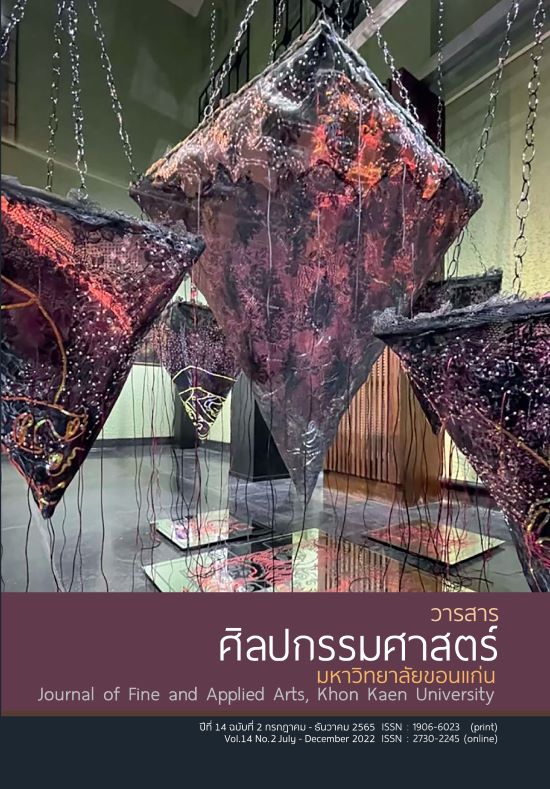Nagas as an Administrative Mechanism of the Rulers Through the Soft Power Concept: The Case Study of Nong Khai Cultural Tourism
Main Article Content
Abstract
This article is part of the research results on the area of belief concerning nagas in Nong Khai province. The objective of this research was to present the perspective in terms of nagas as an administrative mechanism of the ruler through the soft power concept based on the information from the survey, non-participatory observation, unstructured interviews, and related documents and researches.
The study found that nagas are the belief that had been passed down through the form of literature, both in writing and oral history, that appears in the belief related to Buddhism and Hinduism. The traces can be found in myths, literature, sculptures, and paintings. There is also a belief that is found in the naga fireballs phenomenon that occurs in the Mekong River area during the end of Buddhist Lent every year, which is a tool that helps support the creation of the well-known festival of the province.
Therefore, nagas are one of the mechanics in disseminating and continuing the culture through the rulers' soft power concept under the context of religion and belief, strongly connecting the beliefs in nagas and the social and culture of the Isaan and Nongkhai people. Additionally, the phenomenon related to the role of nagas had been added from its traditional role to the cultural tourism aspect of Nong Khai province through the local administration team as a reminder of the cultural and economic values. It can also be said that the nagas can be compared to the mechanism of the rulers both in the context of religion and administration, from the past to the present.
Article Details

This work is licensed under a Creative Commons Attribution-NonCommercial-NoDerivatives 4.0 International License.
Content and information in articles published in the Journal of Fine and Applied Arts of Khon Kaen University is regarded as the opinion and sole responsibility of the author(s) directly; therefore, editors are not obliged to agree to or share any responsibility with regard to the content and information that appears within these articles.
All articles, information, content, image, etc. that have been published in the Journal of Fine and Applied Arts of Khon Kaen University is the copyright of the Journal of Fine and Appllied Arts of Khon Kaen University. Any person or organization who wishes to distribute all or parts of the articles for further dissemination or other usage must first receive permission from the Journal of Fine and Applied Arts of Khon Kaen University before proceeding to do so.
References
กิตติสันต์ ศรีรักษา. (2558). ศิลปกรรมรูปนาคหลวงพระบาง: รูปแบบ คติสัญลักษณ์และการให้ความหมายในฐานะเมืองมรดกโลก. วิทยานิพนธ์ปริญญาปรัชญาดุษฎีบัณฑิต สาขาวิชาวิจัยศิลปะและวัฒนธรรม บัณฑิตวิทยาลัย มหาวิทยาลัยขอนแก่น.
จิตรกร เอมพันธ์. (2545). พญานาค เจ้าแห่งแม่น้ำโขง: พิธีกรรมกับระบบความเชื่อพื้นบ้านแห่งวัฒนธรรมอีสาน. วิทยานิพนธ์ปริญญามานุษยวิทยามหาบัณฑิต คณะรัฐศาสตร์ บัณฑิตวิทยาลัย จุฬาลงกรณ์มหาวิทยาลัย.
ชาญ เกลี้ยงพิบูลย์. (2540). บั้งไฟพญานาคกับการควบคุมทางสังคม: ศึกษาเฉพาะกรณีกิ่งอําเภอรัตนวาปี จังหวัดหนองคาย. สารนิพนธ์ปริญญาสังคมสงเคราะห์ศาสตรมหาบัณฑิต คณะสังคมสงเคราะห์ มหาวิทยาลัยธรรมศาสตร์.
เนชั่นแนลจีโอกราฟฟิกฉบับภาษาไทย. (2560). นาค ความผูกพันในหลากมิติของชนลุ่มน้ำโขง. ค้นเมื่อ 20 ธันวาคม 2563, จาก https://ngthai.com/cultures/14782/myth-of-snake-in-many-culture/
บัววอน พมมะบุด. (2555). การสร้างสรรค์งานภาพพิมพ์โดยได้แรงบันดาลใจจากรูปทรงของแขนนาง แขวงหลวงพระบาง ส.ป.ป.ลาว. วิทยานิพนธ์ปริญญาศิลปกรรมศาสตรมหาบัณฑิต สาขาวิชาวิจัยศิลปะและวัฒนธรรม บัณฑิตวิทยาลัย มหาวิทยาลัยขอนแก่น.
ปฐม หงษ์สุวรรณ. (2554). รายงานวิจัยฉบับสมบูรณ์ โครงการแม่น้ำโขง: ตำนานปรัมปราและความสัมพันธ์กับชนชาติไท. กรุงเทพฯ: สำนักงานกองทุนสนับสนุนการวิจัย.
ปุณณฑรีย์ เจียวิริยบุญญา. (2556). การนิยามความหมายใหม่ของความเชื่อเรื่องนาค: ศึกษากระบวนทัศน์ท้องถิ่นเชิงเปรียบเทียบของกลุ่มชาติพันธุ์ลาว-อีสานในจังหวัดนครพนมและแขวงคำม่วน (สปป.ลาว). วารสารวิถีสังคมมนุษย์, 1(2), 52-69.
พลธรรม์ จันทร์คำ. (2551). พญานาค: อุดมการณ์ที่เมืองคำชะโนดสู่กระบวนการทำให้เป็นสินค้า. วิทยานิพนธ์ปริญญาศิลปศาสตรมหาบัณฑิต สาขาชนบทศึกษาและการพัฒนา สำนักบัณฑิตอาสาสมัคร มหาวิทยาลัยธรรมศาสตร์.
พิเชฐ สายพันธ์. (2539). นาคาคติ อีสานลุ่มน้ำโขง: ชีวิตทางวัฒนธรรมจากพิธีกรรมร่วมสมัย. วิทยานิพนธ์ปริญญาสังคมวิทยาและมานุษยวิทยามหาบัณฑิต สาขามานุษยวิทยา คณะสังคมวิทยาและมานุษยวิทยา มหาวิทยาลัยธรรมศาสตร์.
รุยาภรณ์ สุคนธทรัพย์. (2563). การบริหารจัดการทรัพยากร Soft Power ของไทย. รัฏฐาภิรักษ์, 60(3), 47-55.
วัฒนพันธุ์ ครุฑะเสน. (2557). ปรากฏการณ์บั้งไฟพญานาค: การสร้างนวัตกรรมเพื่อการส่งเสริมการท่องเที่ยวเชิงวัฒนธรรม จังหวัดหนองคาย นครหลวงเวียงจันทน์ และแขวงบอลิคําไซ. วิทยานิพนธ์ปริญญาดุษฎีบัณฑิต สาขาวิจัย ศิลปะและวัฒนธรรม บัณฑิตวิทยาลัย มหาวิทยาลัยขอนแก่น.
สมบูรณ์ บุญฤทธิ์. (2559). พญานาคกับรอยพระพุทบาทในตำนานอุรังคธาตุนิทาน. วารสารมหาจุฬาวิชาการ, 3(2), 43-60.
สำนักงานจังหวัดหนองคาย. (2564). แผนพัฒนาจังหวัด พ.ศ. 2561-2564 (รอบปี พ.ศ. 2564). หนองคาย : กลุ่มงานยุทธศาสตร์และข้อมูลเพื่อการพัฒนาจังหวัด สำนักงานจังหวัดหนองคาย.
สิทธิพล เครือรัฐติกาล. (2551). แนวคิดเรื่อง Soft power และการทูตสาธารณะ (Public Diplomacy). ค้นเมื่อ 15 ธันวาคม 2563, จาก http://kositthiphon.blogspot.com/2008/12/soft-power-public-diplomacy.html
อดุลย์ หลานวงค์. (2560). นาโค นาคี: ความเชื่อกับสถานะในการวางตน. วารสารสถาบันวิจัยพิมลธรรม, 4(1), 1-14.
Nye, J. S. (2004). Soft Power: the means to success in world politics. New York : Public Affairs.


